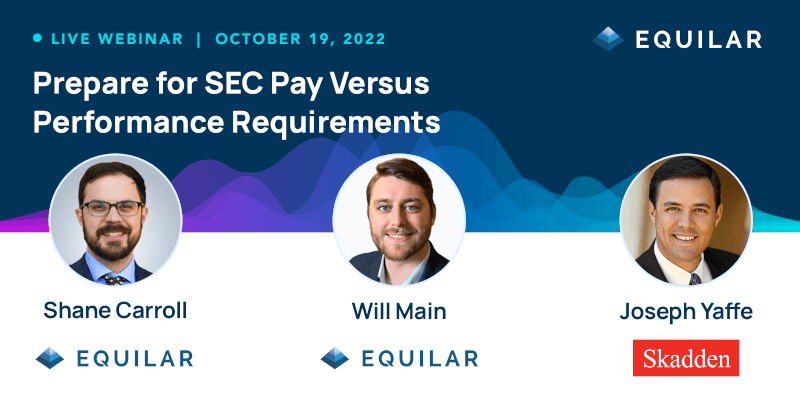Preparing for the 2023 Proxy Season Amid New Pay Versus Performance Requirements
December 22, 2022
Amit Batish

On Aug. 25, 2022, the U. S. Securities and Exchange Commission (SEC) officially adopted its Pay Versus Performance (PvP) rules following several rounds of comments and proposals. The new rules require public companies to disclose information reflecting the relationship between compensation actually paid (CAP) to a company’s named executive officers (NEOs) and the company’s financial performance. Companies with fiscal years ending on or after December 16, 2022, must begin to comply with the new disclosure requirements during the 2023 proxy season.
Consequently, the 2023 proxy season is developing to be one of the most anticipated in recent years. The implementation of the SEC’s requirements, along with growing expectations from investors and other key stakeholders to better align executive pay with corporate performance, is driving companies to quickly determine the best approach to address the new requirements.
For first-year disclosures, a high level of detail and attention to effectively address the new rules will be critical. “The new rules will require issuers, really for the very first time, to disclose compensation in a new and different way than compensation has historically been disclosed in proxies,” said Joe Yaffe, Partner and West Coast Chair, Executive Compensation and Benefits, Skadden, during a recent Equilar webinar. He also noted, “The CAP [calculation] requires [companies] to disclose compensation differently than what’s in the summary compensation table and effectively is intended to provide investors with an overview of the increase in value of equity awards and pension benefits.”
This, coupled with the amount of work that will go into the disclosure process, is posing challenges to companies. “In conversations with many clients, we’re seeing a lot of working groups being put together for finance, legal and HR to collectively tag team their disclosure efforts,” said William Main, Director of Client Services, Equilar. “A number of professionals will be tasked with ultimately performing the valuation work. Some of our clients have fairly sophisticated internal models, where they may be able to do some Monte Carlo simulation in-house to do some of the valuation work. Others are looking elsewhere for valuation experts to kind of help with that piece of it.” With anticipation mounting ahead of the first year of the disclosure requirement, companies are facing pressure from boards and compensation committees to provide an early look at their PvP table well ahead of the proxy season.
The concept of pay for performance has long been advocated by investors, particularly given their influence on pay packages. Investors often seek executive pay plans to align with a company’s financial performance and shareholder return; when that alignment is not as evident, executive pay is likely to come under scrutiny. Say on Pay has bridged this gap in the last decade: Say on Pay is a non-binding advisory shareholder vote of approval or disapproval of top executive compensation packages. Since its inception, Say on Pay rules have continued to play a pivotal role in providing investors a platform to voice discontent over executive compensation pay practices. However, despite the influential voice investors hold, the vast majority of executive pay packages are approved by shareholders. According to Equilar research, 97.5% of the Equilar 500—the 500 largest U.S. companies by revenue—passed Say on Pay in 2022.
While it is early to draw any conclusions about whether Pay Versus Performance rules will have any impact on Say on Pay outcomes in the coming years, it is in companies’ best interest to begin preparing how to tell their pay story. “Investors who have expressed concerns about executive compensation in prior years or whose policies have a sharper focus on executive compensation are going to take a much greater interest [in the new Pay Versus Performance disclosure],” said Yaffe. “I think a lot of the extent to which companies provide more or less fulsome disclosure is frankly going to depend on the overall story of their executive compensation program relative to their performance.” Ultimately, developing a clear and cohesive narrative on the link between pay and performance will ensure a higher likelihood of shareholder support. Companies must also prioritize engagement with shareholders, effectively explain their rationale for the use of particular performance measures and address all pay practices thoroughly if they do receive a Say on Pay failure.
While the new disclosure requirements are capturing attention across the governance landscape, the frequency of pay for performance disclosures has been relatively small. Companies across industries in the United States have disclosed pay for performance graphs in their proxies since the implementation of the Dodd-Frank Wall Street Reform and Consumer Protection Act in 2010. However, the prevalence of companies that disclosed a pay for performance graph has steadily declined over the last five years, according to Equilar research.
Figure 1: Prevalence of Pay for Performance Graph Proxy Disclosures (Equilar 100)

In 2021, only 9% of the Equilar 100—the 100 largest U.S. public companies by revenue—disclosed a graph that showed the relationship between their executives and financial performance. While this has increased by one percentage point from 2020, the figure is down overall by more than 50% since 2017, when 18.2% of companies disclosed a pay for performance graph. The percentage of companies that disclosed a pay for performance graph also declined from 2017 to 2020 before slightly rebounding in 2021. The decline in usage may be due to a more long-term vision of pay and performance alignment, as urged by institutional investors over recent years, potentially easing pressure off companies to disclose related graphs. Another factor contributing to this trend is heightened market volatility that has made companies reluctant to disclose a particular narrative around pay for performance, as the stock price is often an area of focus in these respective disclosures. However, due to the SEC’s August announcement, it is expected that the prevalence of disclosures will accelerate this proxy season.
Ultimately, disclosing this information may prove to be paramount during the 2023 proxy season. Yaffe argues that companies with the most cohesive disclosures will put a premium on understanding the mathematical relationships and converting that into an easy-to-understand narrative that is consistent with the rest of the Compensation, Discussion and Analysis (CD&A). “If you think about what disclosures looked like over the last several years, while performance targets are alluded to and mentioned, the actual relationship between them and company performance has not been given a lot of air, and that requires, I think, a deeper dive into more scrutiny.” Nevertheless, the next few months will prove to be crucial in terms of planning.
The 2023 proxy season should set the stage for how the new Pay Versus Performance disclosures will be presented over the next several years. The rules will likely be favored by investors as they provide additional information on executive pay packages. While their reaction remains unclear, it will certainly become more evident heading into next year’s annual meeting. Nonetheless, the disclosures will introduce an added layer of complexity as boards and compensation committees design executive pay packages for future years.
Equilar and Equity Methods have partnered to develop a new Monte Carlo Simulator. This revolutionary new tool helps companies accurately determine the present value of market-based awards, enabling them to stay ahead of the curve in preparation for the new SEC Pay Versus Performance rule. To learn more about the Monte Carlo Simulator, visit www.equilar.com/equity-valuation or contact us at info@equilar.com.
Contact

Amit Batish
Director of Content & Communications at Equilar
Amit Batish, Director of Content & Communications at Equilar, authored this post. Please contact Amit Batish at abatish@equilar.com for more information on Equilar research and data analysis.
 Solutions
Solutions















